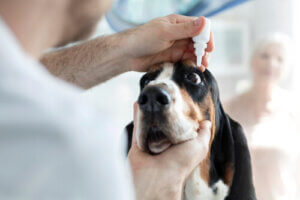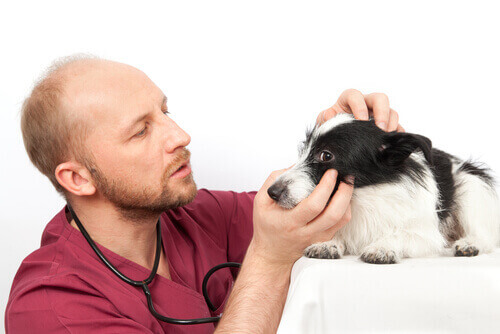Corneal Ulcers in Dogs - Tips and Treatments


Written and verified by the vet Juan Pedro Vazquez Espeso
The eyes are one of the most complex organs in the body. There are many pathological processes that can affect these structures due to their complexity. You may not be aware of it but the more complicated something is, the more likely it is to break down. Among all of the possible alterations, the one we’ll deal with here today stands out for its insidious nature: corneal ulcers.
What exactly are corneal ulcers?
If you’ve ever seen the structure of an eye then you’ll know it has a cover on the outside called the cornea. Well, a corneal ulcer is nothing more than a loss of continuity in this outer layer of the eyeball. It’s usually associated with intense discomfort or severe pain, depending on the extent of the injury. There’s also inflammation, discharge, tearing, and photophobia (fear of light) among other things.
Causes and preventive tips
Causes
Mechanical causes are the most common in corneal ulcers. They might involve trauma, burns, or foreign bodies as external causative elements. As for anatomical alterations, all those pertaining to the eyelids or eyelashes are involved.
- Entropion is an eyelid alteration in which the eyelid grows towards the eyeball.
- Ectopic eyelashes happen when an eyelash is born in an abnormal area producing friction in the eyeball.
- Distichiasis is a congenital abnormality that produces an abnormal growth of eyelashes into the eye instead of outward.
In addition, biological agents such as viruses can cause this type of injury.
Bacteria are usually present in many ulcers, although they’re not the main cause. They’re just a side effect most of the time.

Preventive tips
Now that you know the main causes, check out our tips to prevent corneal ulcers:
- Check the animal’s eyes frequently, especially after walks if they’ve been in contact with plants. This is because a foreign body could have lodged itself in their eyes. Thus, the sooner you remove it, the less important an injury will be. You might want to bring along some water to do a deep eyewash in the event this happens.
- Solve anatomical alterations, whenever possible. This is because the early surgical resolution will prevent any derived consequences.
- Exercise extreme precautions whenever you handle potentially harmful products. For instance, at the shop where you’re constantly producing metal chips or sparks, or handling toxic chemicals at home. You must always take precautions and keep your dog at a safe distance in any of these scenarios.
Treatment for corneal ulcers
If, despite your precautions, your animal pal still develops a corneal ulcer, you must immediately take them to the vet for proper treatment.
The therapeutic measures, in general, are:
- Firstly, eliminate the cause. That is, you must remove the foreign body or substance.
- Reduce pain. This is because this process can be uncomfortable and painful. Along these lines, the vet will most likely apply an anti-inflammatory and an analgesic treatment that might be topical, systemic, or come in the form of eye drops.
- In all of these situations, you must keep their eyes protected as they’ll try to scratch themselves and worsen the condition. Thus, use a dog recovery collar to avoid complications during the healing process.
- The use of antibiotics is recommended as secondary infections usually occur even when the ulcer is the result of trauma.
- A dog might require surgery in certain cases of extensive, deep, or long-lasting ulcers.

The eyes are one of the most complex organs in the body. There are many pathological processes that can affect these structures due to their complexity. You may not be aware of it but the more complicated something is, the more likely it is to break down. Among all of the possible alterations, the one we’ll deal with here today stands out for its insidious nature: corneal ulcers.
What exactly are corneal ulcers?
If you’ve ever seen the structure of an eye then you’ll know it has a cover on the outside called the cornea. Well, a corneal ulcer is nothing more than a loss of continuity in this outer layer of the eyeball. It’s usually associated with intense discomfort or severe pain, depending on the extent of the injury. There’s also inflammation, discharge, tearing, and photophobia (fear of light) among other things.
Causes and preventive tips
Causes
Mechanical causes are the most common in corneal ulcers. They might involve trauma, burns, or foreign bodies as external causative elements. As for anatomical alterations, all those pertaining to the eyelids or eyelashes are involved.
- Entropion is an eyelid alteration in which the eyelid grows towards the eyeball.
- Ectopic eyelashes happen when an eyelash is born in an abnormal area producing friction in the eyeball.
- Distichiasis is a congenital abnormality that produces an abnormal growth of eyelashes into the eye instead of outward.
In addition, biological agents such as viruses can cause this type of injury.
Bacteria are usually present in many ulcers, although they’re not the main cause. They’re just a side effect most of the time.

Preventive tips
Now that you know the main causes, check out our tips to prevent corneal ulcers:
- Check the animal’s eyes frequently, especially after walks if they’ve been in contact with plants. This is because a foreign body could have lodged itself in their eyes. Thus, the sooner you remove it, the less important an injury will be. You might want to bring along some water to do a deep eyewash in the event this happens.
- Solve anatomical alterations, whenever possible. This is because the early surgical resolution will prevent any derived consequences.
- Exercise extreme precautions whenever you handle potentially harmful products. For instance, at the shop where you’re constantly producing metal chips or sparks, or handling toxic chemicals at home. You must always take precautions and keep your dog at a safe distance in any of these scenarios.
Treatment for corneal ulcers
If, despite your precautions, your animal pal still develops a corneal ulcer, you must immediately take them to the vet for proper treatment.
The therapeutic measures, in general, are:
- Firstly, eliminate the cause. That is, you must remove the foreign body or substance.
- Reduce pain. This is because this process can be uncomfortable and painful. Along these lines, the vet will most likely apply an anti-inflammatory and an analgesic treatment that might be topical, systemic, or come in the form of eye drops.
- In all of these situations, you must keep their eyes protected as they’ll try to scratch themselves and worsen the condition. Thus, use a dog recovery collar to avoid complications during the healing process.
- The use of antibiotics is recommended as secondary infections usually occur even when the ulcer is the result of trauma.
- A dog might require surgery in certain cases of extensive, deep, or long-lasting ulcers.

This text is provided for informational purposes only and does not replace consultation with a professional. If in doubt, consult your specialist.








